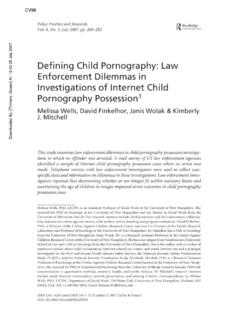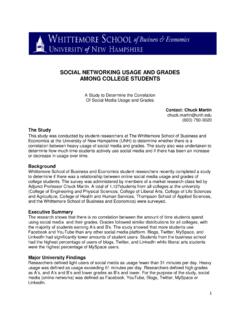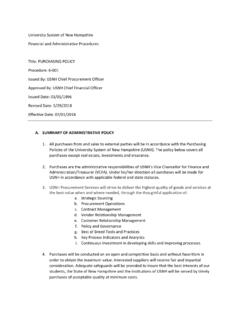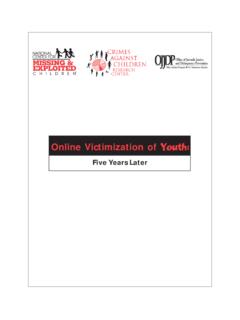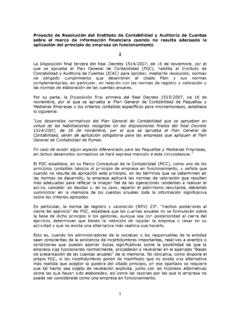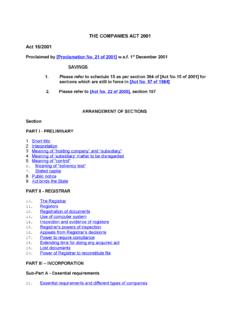Transcription of TABLE OF CONTENTS - University of New Hampshire
1 M E THOD OLOGY R EPORT : 3 R D N AT IONA L. J UV ENILE O NL INE V IC T IM IZAT ION. (NJOV3) S T UDY: S EX T ING S TU DY. A C O M P O N E N T O F WAV E 3 O F T H E N J OV LO N G I T U D I N A L S T U DY. SEXTING CASES HANDLED BY LAW ENFORCEMENT IN 2008 &. 2009. Janis Wolak Kimberly Mitchell David Finkelhor TABLE OF CONTENTS . Section 1: Summary Section 2: Sample Selection Phase 1: National mail survey of law enforcement agencies Phase 2: Telephone interviews about specific cases Section 3: Confidentiality Section 4: Instrument Design The mail survey The telephone interview Section 5: Criteria for Eligibility Section 6: Data Collection Phase 1: Procedures for the national mail survey of law enforcement agencies Phase 2: Procedures for the telephone interviews about specific cases Section 7: Data Cleaning and Coding Qualitative data Quantitative data Section 8: Weighting and Variance Estimates Sample design and probabilities of selection Estimation and variance estimation Acknowledgements References September 2011.
2 Methodology Report, NJOV3, Law Enforcement Sexting Study, page 2. SECTION 1. SUMMARY. The Third National Juvenile Online Victimization (NJOV3) Study was conducted by the Crimes against Children Research Center at the University of New Hampshire and funded by Grant No. 2009-SNB-90001, awarded by the Office of Juvenile Justice and Delinquency Prevention, Office of Justice Programs, Department of Justice. The NJOV3 Study had three related components. The NJOV3 Sexting Study used a two-phase process to collect data about the prevalence and characteristics of sexting cases handled by police during 2008 and 2009. In phase 1, we sent mail surveys to a national sample of law enforcement agencies asking if they had handled such cases during the timeframe of the study.
3 In phase 2, we conducted telephone interviews with investigators about specific cases reported in the mail surveys. The final data set, weighted to account for sampling procedures and non-response, includes data about 675 specific cases. The NJOV3 Arrest Study examined technology-facilitated child sexual exploitation crimes ending in arrest in 2009 ( , sex offenders using the Internet to meet minors, solicitations to undercover investigators posing online as minors, downloading of child pornography). The Arrest Study was a longitudinal study of law enforcement agencies that was preceded by two previous waves. Wave 1 (NJOV1) pertained to arrests for technology-facilitated crimes that occurred between July 1, 2000 and June 30, 2001; Wave 2.
4 (NJOV2) pertained to arrests during 2006. It used the same two-phase data collection process described above. The NJOV3 Prosecutor Study involved interviews with prosecutors about strategies for handling technology-facilitated child sexual exploitation crimes. SECTION 2. SAMPLE SELECTION. For the NJOV3 Law Enforcement Sexting Study, researchers collected information from a national sample of law enforcement agencies. The goal of this methodology was to 1) utilize a representative national sample of law enforcement agencies that would give us an overall picture of sexting incidents known to law enforcement in the United States, 2) understand how these cases emerged and were handled in a diverse group of agencies, and 3).
5 Get detailed data about the characteristics of these crimes from well-informed, reliable sources. Section National mail survey of law enforcement agencies The NJOV3 sample of law enforcement agencies used for both the Sexting and Arrest Studies was designed to yield a nationally representative sample of cases. We used a three-frame stratified sample of agencies because cases involving technology-facilitated crimes do not occur with equal probability among the more than 15,000 US law enforcement agencies. We divided agencies into three sampling frames based on their specialization, training or known experience with technology-facilitated sex crimes against minors, including sexting incidents. This was done so that we could get information from the agencies that were most likely to see these types of crimes while still allowing every agency a chance to be selected for the sample.
6 The sample was designed for the first NJOV Study, with some changes made in the second and third waves to accommodate alterations in the status of sampled agencies ( , some agencies began to specialize in technology-facilitated crimes; some ceased to exist). The NJOV3 first frame sample consisted of 176 agencies. In NJOV3 some agencies were added to the first frame became they were known to have handled sexting cases during the timeframe of the study (2008 & 2009). First frame agencies included 61 Internet Crimes Against Children (ICAC) Task Forces, which are funded by the US. Department of Justice to investigate technology-facilitated child sexual exploitation crimes; 38 agencies which were satellite ICAC Task Forces during Wave 1; 16 agencies which were known to work with civilian groups that conducted independent investigations of Internet-related crimes (included for the NJOV2 Study), and 61 agencies that, according to media reports, had handled sexting cases.
7 We did not sample first frame agencies; rather, we surveyed all of them. Of the 176 first frame agencies that received mail surveys, 3% (n=5) lacked jurisdiction. Of the 171 eligible agencies, 81% (n=138) returned completed Methodology Report, NJOV3, Law Enforcement Sexting Study, page 3. surveys and 46% (n=79) reported handling one or more sexting cases. In addition, two federal agencies were included in the study with certainty. These were not counted in the mail survey sample because they reported their cases electronically rather than through mail surveys due to large caseloads. (See TABLE 1 for the dispositions, by frame, of the NJOV3 Law Enforcement Sexting Study mail survey sample.). The second frame consisted of agencies that we considered more likely than other agencies to have investigated technology-facilitated child sexual exploitation crimes because they had staff that had received training in these types of cases.
8 We identified these trained agencies prior to NJOV1 by using lists of agencies participating in week- long training programs. The lists were acquired from two training organizations, SEARCH and the National Center for Missing & Exploited Children. Also, an additional agency from a large metropolitan area was included with certainty in the second frame to ensure that agencies from all major metropolitan areas in the were included in the sample. There were 1,636 agencies in the NJOV3 Study second frame population, with approximately 50%. selected to receive the mail survey. (These agencies were selected in Wave 1 (NJOV1) and resurveyed in NJOV2. and NJOV3.). Of the second frame agencies that received mail surveys in Wave 3 (n=815), 3% (n=28) were ineligible to participate because they lacked jurisdiction to investigate technology-facilitated child sexual exploitation crimes or the agency no longer existed.
9 (Ineligible agencies were typically small town agencies that relied on county or other larger jurisdictions to conduct criminal investigations.) Of the 787 eligible second frame agencies, 84% (n=659). completed and returned mail surveys, and 29% (n=229) reported handling one or more sexting cases. The third frame consisted of the remaining 13,572 local, county and state law enforcement agencies across the US. The third frame sample was drawn using a database available through the National Directory of Criminal Justice Data (National Directory of Law Enforcement Administrators, 2009). This dataset included an annually updated census of local, county, and state law enforcement agencies and was designed to provide geographic and other identifying information for each record included in either the FBI's Uniform Crime Reports files or the Bureau of Justice Statistic's Directory of Law Enforcement Agencies.
10 The agencies in the first and second frames were cross-referenced with third frame agencies in the database to avoid duplication among the three frames. Of the 13,572 third frame agencies, approximately 12% (n=1,662) were randomly selected to participate in the study. (These agencies were selected in NJOV1 and resurveyed in NJOV2 and NJOV3.) Of the 1,662 third frame agencies that received mail surveys in Wave 3, 9% (n=157) were ineligible to participate because they lacked jurisdiction to investigate technology-facilitated child sexual exploitation crimes, the agency no longer existed, or the agency was a duplicate of another agency within the third frame. Of the 1,505 eligible agencies, 88% (n=1,331) completed and returned mail surveys, and 14% (n=210) reported one or more sexting cases.
